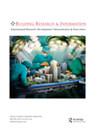Impact of COVID-19 protocols on IEQ and students’ perception within educational buildings in Southern Spain
IF 3.7
3区 工程技术
Q1 CONSTRUCTION & BUILDING TECHNOLOGY
引用次数: 5
Abstract
ABSTRACT The COVID-19 pandemic has highlighted the fact that air quality is essential in buildings. In the case of educational buildings, teaching activities were moved to an online format during the 2020/2021 academic year, with only activities such as exams remaining face-to-face. This strategy required the development of protocols to ensure that classrooms were safe spaces. This study assesses the impact of these protocols in the indoor environmental conditions of educational buildings in Southern Spain. For this purpose, a measurement campaign was carried out at the Fuentenueva Campus of the University of Granada. The results show that the protocols have guaranteed effective ventilation. However, other indoor environmental variables have also been affected, including the satisfaction of users during exams due to temperature, relative humidity (RH) and noise. The highest levels of satisfaction were related to indoor lighting, while the highest levels of dissatisfaction were related to the indoor thermal environment. Among the main causes of dissatisfaction were draughts and outdoor noise, directly related to natural ventilation protocols during the pandemic. Based on these findings, current pandemic protocols should be revised and redesigned to minimize the impact on student satisfaction and perceived learning performance from the identified environmental sources in this research.COVID-19协议对西班牙南部教育建筑内IEQ和学生感知的影响
摘要新冠肺炎疫情突出表明,空气质量在建筑中至关重要。就教育建筑而言,2020/2021学年的教学活动改为在线形式,只有考试等活动保持面对面。这一战略要求制定协议,以确保教室是安全的空间。本研究评估了这些协议对西班牙南部教育建筑室内环境条件的影响。为此,在格拉纳达大学Fuentueva校区开展了一项测量活动。结果表明,该方案保证了有效的通风。然而,其他室内环境变量也受到了影响,包括用户在考试期间因温度、相对湿度和噪音而产生的满意度。最高的满意度与室内照明有关,而最高的不满意度与室内热环境有关。不满的主要原因是通风和户外噪音,这与疫情期间的自然通风协议直接相关。基于这些发现,应修订和重新设计当前的疫情协议,以最大限度地减少本研究中确定的环境来源对学生满意度和感知学习成绩的影响。
本文章由计算机程序翻译,如有差异,请以英文原文为准。
求助全文
约1分钟内获得全文
求助全文
来源期刊

Building Research and Information
工程技术-结构与建筑技术
CiteScore
8.60
自引率
7.70%
发文量
43
审稿时长
>12 weeks
期刊介绍:
BUILDING RESEARCH & INFORMATION (BRI) is a leading international refereed journal focussed on buildings and their supporting systems. Unique to BRI is a focus on a holistic, transdisciplinary approach to buildings and the complexity of issues involving the built environment with other systems over the course of their life: planning, briefing, design, construction, occupation and use, property exchange and evaluation, maintenance, alteration and end of life. Published articles provide conceptual and evidence-based approaches which reflect the complexity and linkages between cultural, environmental, economic, social, organisational, quality of life, health, well-being, design and engineering of the built environment.
 求助内容:
求助内容: 应助结果提醒方式:
应助结果提醒方式:


